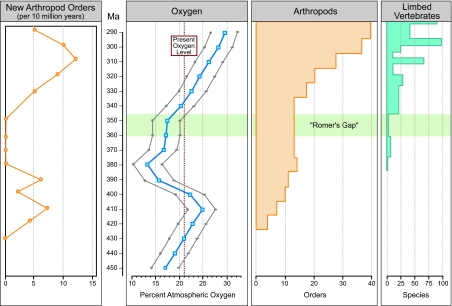Fig. 2.
Ordinal-level diversity data for arthropods from Fig. 1, shown in 10-My bins, plotted against atmospheric O2 levels as computed with the GEOCARBSULF model and ±3% error margins. Over the study interval O2 levels rise significantly above 21% (present level), then subside to <15%, before a subsequent and sustained increase. The first event of Phase 1 land colonization by arthropods apparently is tied to rising atmospheric O2 with a slight time lag. Although both arthropod and limbed vertebrate clades survive the low-O2 interval, they do so at low standing diversity, are composed of long-lived taxa, and are significantly supplemented by the emergence of minimally terrestrialized vertebrate clades in the second event of Phase 1 (from Fig. 1). Most revealing is that no new arthropod and very few stegocephalian taxa originate during the low-O2 interval. A more dramatic Phase 2 of land colonization is linked to a second, more elevated rise in atmospheric O2. Data are plotted as midpoints within 10-My bins.

